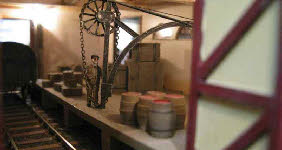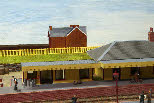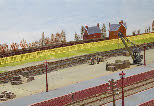


However, there are several areas of the backscene where at least a basic understanding of perspective is useful. I have several hedges which run from the front to the back of the layout, and need to continue onto the backscene to give a sense of depth; the road across the level crossing which somehow needs blend the backscene; and most difficult of all, there is a pair of railway cottages immediately north of the station which rather dominate the central part of the back scene.
A technical treatise on perspective is rather beyond me, but there are plenty of useful hints and tips on the internet. I spent perhaps rather longer than I needed to, working out the perspective for the buildings. The first thing is to understand the principles of two-point perspective - ie with a vanishing point to both left and right. Once this has been grasped, the main things to consider are:
- the height of the eyeline relative to the building. Normal eyeline would be eye height - 6ft or so above ground level. However for the layout spectator the eyeline will be higher. I’ve set mine at just above roof level, which means the viewer is looking slightly down on the building.
- the second thing is the size of the building - height, width and also viewing point (ie three-quarter view for example).
- the final consideration is the position of the two vanishing points. This is partly dictated by the orientation of the building, but there is also the fact that the closer the two vanishing points are, relative to the size of the building, the closer the building will look to the viewer (regardless of its size). Making the building smaller doesn’t help, because the position of the vanishing points dictates the degree of perspective distortion. For a reasonably distant building, make sure the vanishing points are quite a long way apart. For the building shown here, I made the original sketch on a CAD drawing package, and started with my ‘paper’ 3000mm long. The right hand vanishing point is about 1500mm to the right, and the left hand, about 600mm to the left.
Having said all this, there is no point in going to huge lengths to determine any of the above, for the simple reason that however accurate your perspective drawing might be, it will only look correct from one viewpoint, and the further left or right the viewer moves, the less ‘3-dimensional’ the object will look. Artists have a definite advantage here - paintings are usually only viewed from a fairly limited frontal angle, and perspective should look ok within this. For a model back-scene, however, the viewer can wander freely along the layout, and get all sorts of distorted views of your best effort.
 The photo shows the first (not quite finished) building from its intended view point. Just the windows and chimney pots to add, plus a bit of highlighting. There is another house to add to the left of this -
The photo shows the first (not quite finished) building from its intended view point. Just the windows and chimney pots to add, plus a bit of highlighting. There is another house to add to the left of this - now sadly demolished, so although I have a basic plan (from a 1910 OS map) I don’t have too much detail on the appearance of the house itself.
 The photo on the right shows the building again from a slightly different viewpoint and it can be seen that the perspective is now not quite right. It also shows the road crossing the railway and disappearing into the distance. In reality, the road dips away from the railway, and also heads off towards the left of the scene, behind the house. This has worked out very conveniently because I can make the road naturally disappear into the dip. However, I have added the electricity poles (which were there in 1910, and are still there), making them reduce in size to give the appearance of distance.
The photo on the right shows the building again from a slightly different viewpoint and it can be seen that the perspective is now not quite right. It also shows the road crossing the railway and disappearing into the distance. In reality, the road dips away from the railway, and also heads off towards the left of the scene, behind the house. This has worked out very conveniently because I can make the road naturally disappear into the dip. However, I have added the electricity poles (which were there in 1910, and are still there), making them reduce in size to give the appearance of distance.

 There is still more to do on the backscene -
There is still more to do on the backscene - more trees to add, and detail to add to the back gardens of the houses for example, but I remain amazed at what a difference a relatively simple backscene has made to the apparent width of the model - it looks a lot wider than 2ft now. The last four photos show views from west to east of these more-or-less completed sections.


A technical treatise on perspective is rather beyond me, but there are plenty of useful hints and tips on the internet. I spent perhaps rather longer than I needed to, working out the perspective for the buildings. The first thing is to understand the principles of two-
Having said all this, there is no point in going to huge lengths to determine any of the above, for the simple reason that however accurate your perspective drawing might be, it will only look correct from one viewpoint, and the further left or right the viewer moves, the less ‘3-
 The photo shows the first (not quite finished) building from its intended view point. Just the windows and chimney pots to add, plus a bit of highlighting. There is another house to add to the left of this -
The photo shows the first (not quite finished) building from its intended view point. Just the windows and chimney pots to add, plus a bit of highlighting. There is another house to add to the left of this - The photo on the right shows the building again from a slightly different viewpoint and it can be seen that the perspective is now not quite right. It also shows the road crossing the railway and disappearing into the distance. In reality, the road dips away from the railway, and also heads off towards the left of the scene, behind the house. This has worked out very conveniently because I can make the road naturally disappear into the dip. However, I have added the electricity poles (which were there in 1910, and are still there), making them reduce in size to give the appearance of distance.
The photo on the right shows the building again from a slightly different viewpoint and it can be seen that the perspective is now not quite right. It also shows the road crossing the railway and disappearing into the distance. In reality, the road dips away from the railway, and also heads off towards the left of the scene, behind the house. This has worked out very conveniently because I can make the road naturally disappear into the dip. However, I have added the electricity poles (which were there in 1910, and are still there), making them reduce in size to give the appearance of distance.
 There is still more to do on the backscene -
There is still more to do on the backscene -
